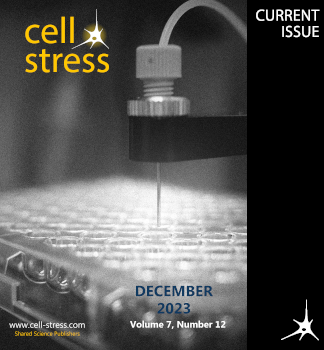A versatile method for the identification of senolytic compounds
IF 3
Q2 CELL BIOLOGY
引用次数: 0
Abstract
The increased burden of senescent cells is as a well-established hallmark of aging and age-related diseases. This finding sparked significant interest in the identification of molecules capable of selectively eliminating senescent cells, so-called senolytics. Here, we fine-tuned a method for the identification of senolytics that is compatible with high-content fluorescence microscopy. We used spectral detector imaging to measure the emission spectrum of unlabeled control or senescent cells. We observed that senescent cells exhibited higher levels of autofluorescence than their non-senescent counterparts, particularly in the cytoplasmic region. Building on this result, we devised a senolytic assay based on co-culturing quiescent and senescent cells, fluorescently tagged in the nuclear region through the overexpression of H2B-GFP and H2B-RFP, respectively. We validated this approach by showing that first generation senolytics were effective in reducing the number of RFP+ nuclei leaving the count of GFP+ nuclei unaffected. The result was confirmed by flow cytometry analysis of nuclei isolated from these quiescent-senescent cell co-cultures. We found that this system enables to capture cell type-specific effects of senolytics as in the case of fisetin, which kills senescent Mouse Embryonic Fibroblasts but not senescent human melanoma SK-MEL-103 cells. This approach is amenable to genetic and chemical screening for the discovery of senolytic compounds in that it overcomes the limitations of current methods, which rely upon costly chemical reagents or fluorescence microscopy using cells labeled with fluorescent cytoplasmic probes that overlap with the autofluorescence signal emitted by senescent cells.鉴定衰老化合物的多功能方法
衰老细胞数量的增加是衰老和老年相关疾病的一个公认标志。这一发现激发了人们对鉴定能够选择性消除衰老细胞的分子(即所谓的衰老剂)的极大兴趣。在这里,我们微调了一种与高含量荧光显微镜兼容的鉴定衰老物质的方法。我们使用光谱探测器成像技术来测量未标记的对照细胞或衰老细胞的发射光谱。我们观察到衰老细胞比非衰老细胞表现出更高水平的自发荧光,尤其是在细胞质区域。在这一结果的基础上,我们设计了一种基于静止细胞和衰老细胞共培养的衰老检测方法,通过过表达 H2B-GFP 和 H2B-RFP 分别在细胞核区域进行荧光标记。我们对这种方法进行了验证,结果表明第一代衰老剂能有效减少 RFP+ 核的数量,而 GFP+ 核的数量不受影响。对从这些静止-衰老细胞共培养物中分离出来的细胞核进行流式细胞术分析证实了这一结果。我们发现,该系统能捕捉衰老剂对细胞类型的特异性影响,如非西丁能杀死衰老的小鼠胚胎成纤维细胞,但不能杀死衰老的人类黑色素瘤 SK-MEL-103 细胞。目前的方法依赖于昂贵的化学试剂或荧光显微镜,使用的细胞标记有荧光胞质探针,这些探针与衰老细胞发出的自发荧光信号重叠。
本文章由计算机程序翻译,如有差异,请以英文原文为准。
求助全文
约1分钟内获得全文
求助全文
来源期刊

Cell Stress
Biochemistry, Genetics and Molecular Biology-Biochemistry, Genetics and Molecular Biology (miscellaneous)
CiteScore
13.50
自引率
0.00%
发文量
21
审稿时长
15 weeks
期刊介绍:
Cell Stress is an open-access, peer-reviewed journal that is dedicated to publishing highly relevant research in the field of cellular pathology. The journal focuses on advancing our understanding of the molecular, mechanistic, phenotypic, and other critical aspects that underpin cellular dysfunction and disease. It specifically aims to foster cell biology research that is applicable to a range of significant human diseases, including neurodegenerative disorders, myopathies, mitochondriopathies, infectious diseases, cancer, and pathological aging.
The scope of Cell Stress is broad, welcoming submissions that represent a spectrum of research from fundamental to translational and clinical studies. The journal is a valuable resource for scientists, educators, and policymakers worldwide, as well as for any individual with an interest in cellular pathology. It serves as a platform for the dissemination of research findings that are instrumental in the investigation, classification, diagnosis, and therapeutic management of major diseases. By being open-access, Cell Stress ensures that its content is freely available to a global audience, thereby promoting international scientific collaboration and accelerating the exchange of knowledge within the research community.
 求助内容:
求助内容: 应助结果提醒方式:
应助结果提醒方式:


